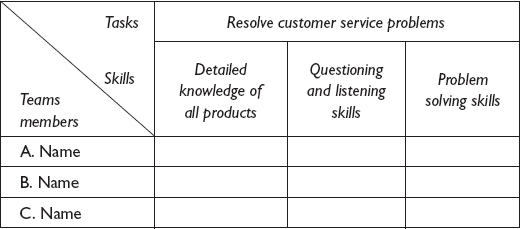Session A
Planning and allocating
work
 1 Introduction
1 Introduction
The primary responsibility of first line managers is to make sure that the teams they manage do their work efficiently and effectively. Efficiently means that they use the minimum of resources to the maximum effect. Effectively means making the best use of the resources so that the goods or services that are produced are to the required quality standards. Everything you do is about achieving that goal.
To do this you need to ensure that the people you manage, the people in the team you lead, are making the best use of their skills to do the tasks that are required, what has sometimes been described as ‘working smarter not harder’. In this first session we will explore how you can make sure that you are doing this, identifying the tasks that need doing, the people you have available to do them, and how best to match the one to the other.
 2 What needs to be done?
2 What needs to be done?
Most organizations have some system for planning their future workload. The level of detail and the length of time over which this planning extends depends on the type of organization and its market. For example, an oil refinery engaged in continuous production, 24 hours a day, seven days a week, 52 weeks a year, may well have plans for the production of different categories of fuel (diesel, petrol, heating oil, etc.) throughout the year. On the other hand, a hairdresser can only plan a week or so ahead, based on customer bookings. An oil refinery cannot switch production off and on at will, whereas a hairdresser can ask staff to work an extra hour or get part time staff to extend their hours to cope with a ‘blip’ in demand. In the next section we'll look at the ability to respond to demand, but for now we'll focus on the ability to forecast what is needed and to plan work accordingly.
2.1Responding to demand
Most organizations are driven by the demand for the goods or services they supply, whether they are in the public, private or voluntary sector. Sometimes this demand is relatively even throughout the year, but may be growing or declining over time. This is what is called the trend. Sometimes demand may fluctuate, with peaks and troughs at specific times. These are called seasonal variations. Others may suffer from unanticipated fluctuations due to events that could not be predicted (or, at least, not predicted when they would occur). For example:
![]() A hospital may have a constant demand for eye operations but with an upward trend as people live longer and suffer from age-related eye problems. It can also expect that demand for beds will be higher in winter (seasonal variation), as people suffer more from illnesses (especially older people) and injuries (more car crashes in dark, wet weather). It may also find itself inundated with patients due to a particularly virulent strain of ’flu – it can plan for such a sudden increase but doesn't know when or if it will occur.
A hospital may have a constant demand for eye operations but with an upward trend as people live longer and suffer from age-related eye problems. It can also expect that demand for beds will be higher in winter (seasonal variation), as people suffer more from illnesses (especially older people) and injuries (more car crashes in dark, wet weather). It may also find itself inundated with patients due to a particularly virulent strain of ’flu – it can plan for such a sudden increase but doesn't know when or if it will occur.
![]() An insurance broker may have regular renewals of policies and new customers taking out policies at a fairly even rate, but with a slight downward trend in demand as more and more people buy over the Internet, but it always gets a surge in mid-summer and mid-winter when people change their cars with the change in licence plate numbers, causing them to have to change their insurance. The collapse of an online insurance company may suddenly create a surge of new business.
An insurance broker may have regular renewals of policies and new customers taking out policies at a fairly even rate, but with a slight downward trend in demand as more and more people buy over the Internet, but it always gets a surge in mid-summer and mid-winter when people change their cars with the change in licence plate numbers, causing them to have to change their insurance. The collapse of an online insurance company may suddenly create a surge of new business.
Activity 1 |
 |
Think about your organization; what longer term trends can you see in what is supplied, both the volumes and the mix of different products or services?
Are there any seasonal variations in demand or supply? What causes these?
What could cause a sudden surge (or drop) in demand or the need to supply products or services?
2.2Setting objectives
Most organizations make some effort to forecast what level of products or services they need to produce, and the mix of different types of product or service. They will often do this for at least the year ahead, often for two, three or more years, in outline. They will then plan in more detail for the four quarters of the current year, and the months of the current quarter and sometimes the weeks of the current month. This way they always have plans in increasing levels of detail for the current month and for the next four quarters.
These plans will usually translate into objectives for your team. These may be expressed in different ways depending on what you do. In manufacturing, they are most likely to be volumes of production, reject levels and the like. In services they may be customers served, sales made or processes completed.
If you have agreed your objectives and they are set out as SMART objectives, then you will know what you are expected to do. SMART objectives are Specific, so you know what is expected of you. They are Measurable, so you can judge how well you are meeting them. They are Achievable, so you believe that you are capable of meeting them (or you should not have agreed them). They are Relevant, which means that you can use them as the basis for planning what you are going to do, and they are Time bound, so that you have a clear time period within which to achieve them.
Your task is to convert these objectives into work plans and targets for your team.
 3 What are you capable of doing?
3 What are you capable of doing?
The ability of your team to respond to variations in demand reflects various factors, mainly to do with the kind of resources you use, how people in your team are employed and their skills.
3.1The resources you use
An oil refinery can only do one thing, refine oil, and operates on a continuous production basis. Some manufacturing and service organizations have a bit more flexibility but still operate 24 hours a day, most days of the week and most weeks of the year. They may be able to change what they produce but it takes time, because their mass production system is based on producing standard products although, in recent years, mass production has had to be come more able to produce greater variety, what has been described as mass customization.
Many more organizations operate on a batch production basis. This means that they produce varying quantities (batches) of different products or services. Others operate on a project or commissioned production basis, where each product or service is a one-off event, although they may be based on standard elements or components that are assembled together according to the work that needs to be done.
These differences in how organization operate will often reflect how easily they can expand or contract their production or supply of services, what economists call the elasticity of supply. Organizations which are capital-intensive (have large scale equipment, buildings and facilities) tend to have less flexibility (are less elastic in supply). They can't expand easily because they need to work near to full capacity to be economic, and can't add new capital easily.
Organizations which are labour-intensive (rely mainly on people) can more easily recruit to expand supply (are more supply elastic). However, this assumes that people are readily available, and have the skills needed. Some skills are in short supply, making it hard for organizations relying on them to increase output. Generally, the less you need specialist skills, the easier it is to find people to perform tasks.
Activity 2 |
 |
Think about your organization; how easily can it expand its production of products or services?
How capital or labour intensive is it? (There is no benchmark to use, but think of an oil refinery as the most capital intensive, and an agricultural labour contractor supplying fruit pickers as the most labour intensive.)
How dependent is you organization on specialist skills to supply products or services? Are they readily available or hard to find?
3.2How people are employed
People can be working in an enormous variety of ways, but the main differences are between:
![]() Full-time, fractional, part-time and job-share
Full-time, fractional, part-time and job-share
![]() Permanent, temporary or fixed term contract
Permanent, temporary or fixed term contract
![]() Fixed or flexible hours
Fixed or flexible hours
![]() Shift or daytime only
Shift or daytime only
Full-time, fractional, part-time and job-share employees
Over recent years, part-time workers have had their rights extended to the same basic conditions of employment as full-time workers, and many organizations benefit from being able to employ people to fit into variations in demand or cover for absent employees. Jobshare means that (usually) two employees fill one job role. Fractional posts are more substantial part-timers, usually working at least half the time of full time employees. Fractional, jobshare and part-time working has been more commonly taken up by women to enable them to combine work with childcare responsibilities, and this is one reason that rights have been extended, to prevent sex discrimination in employment.
The ability to employ people on a fractional or part-time basis means that you can expand or contract the level of activity in smaller steps, especially in labour-intensive operations. This makes it easier to respond to small changes in demand, but it can also lead to people being treated as second-class employees. You should always treat people who work less than the hours of full time workers as equal members of the work team in determining how work is planned and allocated.
Permanent, temporary or fixed term contract employees
Part time employees often get confused with temporary employees; they are not the same. Temporary employees, or people who are employed on fixed term contracts, are useful in covering for absent team members and coping with short term variations in demand. Some ‘temps’ are employed by agencies, others are directly employed. They are often treated as second class employees, not properly inducted and used poorly, yet they are often critical in enabling organizations to cope. In planning and allocating work to temporary or fixed term contract employees, take the time to find out what they are capable of and use them as effectively and efficiently as possible, to make it worthwhile employing them.
Fixed or flexible hours employees
Flexible working, or flexitime, has become increasingly common, as employers recognize the benefits of enabling people to work the hours that suit them. This can even out traffic congestion and reduce commuting stress. It can also help to extend the hours of operation by allowing people to come in earlier or stay later as it suits them. Fixed hours are really only needed if the whole team must work co-operatively or there is a need for full staffing during regular working hours. What flexible working can do is to make planning and allocating work a bit more problematic. However, by having clear guidelines on how the flexitime works and the importance of hitting work targets, you will get the benefits of more motivated team members without any significant disadvantages.
Shift or daytime only employees
There was a time when only factories and few other occupations worked shifts. Now, with a 24/7 culture and the growth of call centres, more and more people are working shifts. The original reason for shift working, and the reason it is still used in many capital-intensive industries, is to maximize the use of expensive capital. The reason why it is increasingly used now, however, is to ensure that an organization can supply goods or services at times that customers want them. Shift systems vary from continuous three shift operations, to organizations running short, early evening, (or ‘twilight’) shifts to operate an extended day.
Shift working can bring problems, with team members on different shifts not meeting and productivity varying on different shifts or after changes in shift patterns. Generally, people cannot work as well if their sleep patterns are disturbed. People working constant night shifts suffer because the natural circadian rhythms are based on sleeping at night, and have difficulty adjusting to different patterns of work and sleep.
Activity 3

Which of these different employment patterns does your organization use? How do they affect the way that you plan and allocate work?
3.3The skills people have
The resources you use and the way that people are employed are significant in determining how well your team can meet your work objectives. However, the third aspect is probably the most important of all, the skills that your team has.
Skills cover all aspects of team members’ ability to perform, including their knowledge and their competence or ability to perform in their role, will reflect:
![]() their education and training
their education and training
![]() their experience
their experience
![]() their attitudes and motivation
their attitudes and motivation
![]() their responsibility and control of their work.
their responsibility and control of their work.
Much of this workbook is concerned with these last two elements, because the most able employees can perform badly if they have a poor attitude to work, lack motivation, and feel undervalued and rigidly controlled in what they do. Conversely, someone with only adequate skills can improve in leaps and bounds if they are enthusiastic, properly motivated, given responsibility and control over their work. Ideally, you need to combine high skill levels with a work environment that brings the best out of people. The workbooks Motivating to Perform in the Workplace and Developing Yourself and Others focus on these aspects of your role.
 4 Allocating work to people
4 Allocating work to people
In determining what each person should be doing you need to go through a five stage process:
1 Break down the team's or department's work objectives into specific targets, tasks or activities.
2 Rank these tasks in terms of priority, based on their precedence, urgency and importance. Precedence is the extent to which some tasks depend on the completion of others. A task that has to be completed before something else is done has precedence. Urgency is how soon the tasks need to be completed; importance is how significant the tasks are for achievement of overall goals.
3 Analyse the skills needed for completion of each task, bearing in mind that someone's skills reflect their education and training, experience, attitude, motivation, the ability to accept responsibility and take control.
4 List the skills of the team members, using these same dimensions. You should take account not just of someone's current skills level, but their development needs. Some tasks may serve to provide the experience that someone needs to develop their skill level, or allow someone to take on responsibility or help improve their motivation. Some tasks may also allow those with high skill levels to coach or mentor others to help bring them up to their standard.
5 Match people to the tasks.
A useful tool for doing this is a skills matrix. This is simple chart listing the main tasks in columns, with the specific skills requirements for each in sub-columns. Team members are listed down the side, in rows. For example:

It's possible to identify different stages of skills development:
![]() Not yet skilled
Not yet skilled
![]() Learning
Learning
![]() Skilled
Skilled
![]() Coach
Coach
A coach is able to develop others, and pass on his or her high skill levels. A skills matrix like this makes it clear who is capable of dealing with any task.
Activity 4 |
 |
Do you use a skills matrix, or anything like it? You may have one ‘in your head’, but it is better to use a formal matrix because that way you can discuss some-one's current level of skills and their development plans.
4.1Managing the gaps
In an ideal world there is a perfect match between the tasks and the people available to do them. Unfortunately, we don't live in an ideal world, which is why you often finish up with gaps between the tasks and the people. Gaps can mean that you have tasks without the right people, or people able to do more complex tasks than are needed. In the short term, the lack of appropriately skilled people is the hardest to solve.
Activity 5 |
 |
What can you do if you have tasks and nobody able to perform them?
If the shortfall is due to inadequate levels of staff, then you are faced with having to recruit new people, either permanent or temporary, or sub-contract the work. If it is due to a skill shortage – you have the people but not the right skill mix – recruitment of new employees is not appropriate. Instead you will need to develop existing people. This is often the lowest cost solution to a skill gap, but too many organizations prefer to recruit new employees. On average it costs about one quarter of the first year's salary to recruit someone, and you can get a lot of training for that money. Added to which, training improves motivation and reduces labour staff turnover.
In the long term, under-using skilled people is the bigger problem. It is inefficient, as the organization is paying for skill it's not using. It is also likely to encourage people to lead, as they feel undervalued and under-stretched.
4.2Planning your longer term labour needs
One of the tasks that first line managers are likely to be involved in is helping line managers to plan longer term labour needs. This is similar to the work allocation task, but on a longer time scale and in broader terms. It means looking at:
![]() Forecasts of future work levels (outputs of products and services).
Forecasts of future work levels (outputs of products and services).
![]() Forecasts of future labour productivity (how much each person can produce, on average). This will often have to take into account any planned investment in equipment, systems and training.
Forecasts of future labour productivity (how much each person can produce, on average). This will often have to take into account any planned investment in equipment, systems and training.
![]() Forecasts of employee turnover (how many people you expect to leave, be promoted or retire).
Forecasts of employee turnover (how many people you expect to leave, be promoted or retire).
You can do two simple sums based on this information:
1. |
Divide how much you will be expected to produce or do, per day/week/ month by the amount people can, on average, be expected to produce or do, per day/week/month. This tells you how many people you will need.
2. Number of employees needed – (Current labour force – Forecast number leaving)
Work out how many of the current labour force you will have in the period being discussed (which is the sum in brackets) and take this figure away from the forecast number you will need. The figure you have left is the number of people you will need to recruit or train up from elsewhere during this period to meet demand.
Activity 6 |
 |
In two years’ time an organization expects to be processing 7,500 customer orders per week. It expects customer service people to be able to process 300 orders per week, a 25% increase on current levels. It currently employs 32 people, but three will retire in the next two years, and it usually loses at least three people a year to other jobs. How many people will it need to recruit or train up in the next two years?
The answer to this activity appears on page 106.
Of course, this is not always as easy as this makes it look. However, if you understand the basic principles you can work with managers on calculating the likely recruitment needs. One thing to note, however, is that you could finish up with a negative figure. If the Number of employees needed is less than the number you are likely to have (Current labour force – Forecast number leaving) this is the number that will have to be made redundant.
 5 Controlling people
5 Controlling people
Can people be controlled?
Experience tells us that, in normal working life, managers cannot – and, if they are sensible, don't even attempt to – control every action of the people they manage.
Getting team members to meet objectives and to follow standards is not so much a matter of control as of motivation.
Activity 7

In your own words, describe what you understand by ‘motivation’.
Motivation is about getting people to want to do things, rather than trying to make them do things.
One of the best ways to motivate people to work well is to allow them to have responsibility and control over their own work. Imposing stringent controls usually has the effect of making others less well motivated.
So you could define the task of a team leader as finding the right compromise between the two extremes of attempting to keep every activity under strict personal supervision, and allowing team members to do as they please.
You want to monitor events and activities, because you may need to take action when things start going wrong. Yet if the team feel that they can't do anything without checking with you first, they may feel undervalued and demoralized.
The trick is to build up mutual trust and understanding, and to help create an atmosphere in which everyone wants to make a positive contribution.
5.1Creating the right atmosphere
If you've been lucky enough to have had the experience of being in a group where there is a pleasant, friendly and open climate or atmosphere, you will know how effective such a group can be. It's often because:
![]() members support each other and stand up for each other;
members support each other and stand up for each other;
![]() there is real communication;
there is real communication;
![]() people seem to care about the standards of the group;
people seem to care about the standards of the group;
![]() everyone's views are listened to, and everyone's efforts are appreciated.
everyone's views are listened to, and everyone's efforts are appreciated.
Perhaps you agree that this is the kind of atmosphere every workteam should aim for.
It can't be done overnight, and takes a lot of effort. But it's well worthwhile working at it.
Activity 8 |
 |
What can a first line manager do to help develop this kind of positive atmosphere?
Choose the preferable option from each pair listed below.
| a Tell the team not only what they need to know to do the job, but the background to the work – why it's needed, who the customers are, what will be the effects of getting it wrong, and so on. |
|
OR | b Use the ‘need to know’ principle. Tell the team enough to do the job to the required standard and no more, on the basis that anything else is none of their concern. |
|
| c Discourage discussion, unless it's relevant to the job in hand. |
|
OR | d Encourage discussion about any aspect of the work, the organization and the team. |
|
| e Give responsibility to all team members, as far as you think they are able to handle it. |
|
OR | f Retain as much of the responsibility for yourself as you can. |
|
| g Show the standards of work you expect stamp hard on any failures. |
|
OR | h Give recognition and praise freely and generously. Show that you appreciate the work they do. |
|
| I Don't get involved in the lives and interests of the team; who are you to interfere? |
|
OR | j Make it your job to get to know every individual and to find out what makes him or her ‘tick’ – without intruding into private matters. |
|
You would have done well to choose responses a, d, e, h and j. If you read these paragraphs again, you may agree that they represent what might be called the ‘open and trusting’ approach.
However, you may not totally agree with this approach. You might point out that some groups work well together with a leader who is dour and unbending, who achieves results by setting high standards for himself or herself and expecting others to do the same. We all have our own style. There is no such thing as a fixed set of rules for motivating people.
5.2Job enrichment
These days, organizations are tending to move away from the tradition of breaking jobs down into simple and (often) menial tasks. There is a growing acceptance of the fact that most people:
![]() will take a much more positive attitude to work if they're given the opportunity to use their skills and talents to the full;
will take a much more positive attitude to work if they're given the opportunity to use their skills and talents to the full;
![]() are quite capable of handling responsibility;
are quite capable of handling responsibility;
![]() are much more productive when they enjoy what they're doing.
are much more productive when they enjoy what they're doing.
Activity 9 |
 |
Here are some ideas for enriching jobs. Read it through and for each point, say what you might do to apply the concept to your own team and work situation:
![]() Let individual team members see a whole job through from start to finish, rather than breaking the job down into small tasks.
Let individual team members see a whole job through from start to finish, rather than breaking the job down into small tasks.
![]() Increase the level of responsibility for the job wherever and whenever possible.
Increase the level of responsibility for the job wherever and whenever possible.
![]() Reduce the level of supervision, giving team members greater control over the way they approach a job, the equipment they need and so on.
Reduce the level of supervision, giving team members greater control over the way they approach a job, the equipment they need and so on.
![]() Increase the range of tasks which you delegate.
Increase the range of tasks which you delegate.
![]() Give individuals every opportunity to become expert in some specific task or sphere of activity.
Give individuals every opportunity to become expert in some specific task or sphere of activity.
![]() Seek to widen the scope of jobs for which you and your team are responsible.
Seek to widen the scope of jobs for which you and your team are responsible.
![]() Make sure that jobs are meaningful and that team members can see their relevance.
Make sure that jobs are meaningful and that team members can see their relevance.
There are many possible answers to these questions, and yours will apply only to your own circumstances. For example, you might have written, in response to ‘Increase the level of responsibility for the job wherever and whenever possible’:
![]() ‘Hazel could take responsibility for checking that new jobs are allocated a number, and are entered on the tracking software.’ Or, in your response to ‘Seek to widen the scope of jobs for which you and your team are responsible’:
‘Hazel could take responsibility for checking that new jobs are allocated a number, and are entered on the tracking software.’ Or, in your response to ‘Seek to widen the scope of jobs for which you and your team are responsible’:
![]() ‘I don't see why we could not give candidates a preliminary interview, to save the time of senior staff, and weed out the really unsuitable ones.’
‘I don't see why we could not give candidates a preliminary interview, to save the time of senior staff, and weed out the really unsuitable ones.’
5.3Training and development
A workteam is a wonderful animal. Unlike most equipment, it can be trained and developed to adapt to changing demands and new situations.
You are probably carrying out training all the time. Each time you explain a new process or answer a query, you are adding to the workteam's knowledge. As tasks are performed, team members gradually become more proficient.
Perhaps you have more formal responsibilities for training as well. Whether you run formal training courses yourself, or leave it to a specialist, you play a large part in recognizing training needs, and selecting people for particular training.
Activity 10 |
 |
Introducing a new piece of equipment is one situation that would suggest a need for training. Try to think of two others.
Some examples are as follows:



Training can provide new opportunities for individuals, for the team and for the team leader.
To summarize this section, four points can be made.
![]() Controlling work effectively is not only a matter of organizing and employing specific techniques – it is also about getting the team to want to achieve objectives and to measure up to high standards.
Controlling work effectively is not only a matter of organizing and employing specific techniques – it is also about getting the team to want to achieve objectives and to measure up to high standards.
![]() The better the atmosphere, and the greater the understanding between team members, the more likely it is that work will be successful and under control.
The better the atmosphere, and the greater the understanding between team members, the more likely it is that work will be successful and under control.
![]() Job enrichment is one, very significant, approach to motivation and increased productivity.
Job enrichment is one, very significant, approach to motivation and increased productivity.
![]() Training can give the workteam the chance to develop and broaden its skill base.
Training can give the workteam the chance to develop and broaden its skill base.
The key to controlling work is in managing and motivating the people.
Self-assessment 1

1 Changes in the level of demand or output of products or services over time are caused by upward or downward _____________, _____________variations and ____________ variations.
2 In determining what your team is capable of doing, in term of workload, you need to take account of ________________________, the way that _______________________________ and their ________________.
3 The five stages in allocating work to people are:
1. ___________________________________
2. ___________________________________
3. ___________________________________
4. ___________________________________
5. ___________________________________
4 The number of employees needed in future can be calculated by the formula: _______________________________________________
5 The number of people you will need to recruit or make redundant at a future point in time can be calculated by the formula: _______________ – (_______________ – _______________)
6 How could you recognize what kind of atmosphere – the general feeling or mood – existed in a workplace?
7 Fill in the blanks in the following statements with suitable words chosen from the list underneath.
![]() Controlling work effectively is not only a matter of _____________and employing specific ____________ – it is also about getting the team to _____________ to achieve objectives and to _____________ up to high standards.
Controlling work effectively is not only a matter of _____________and employing specific ____________ – it is also about getting the team to _____________ to achieve objectives and to _____________ up to high standards.
![]() The better the _____________, and the greater the _____________ between team members, the more likely it is that work will be successful and under _____________.
The better the _____________, and the greater the _____________ between team members, the more likely it is that work will be successful and under _____________.
![]() Job _____________ is one, very significant, approach to _____________ and increased _____________.
Job _____________ is one, very significant, approach to _____________ and increased _____________.
![]() _____________ can give the workteam the chance to _____________ and broaden its _____________ base.
_____________ can give the workteam the chance to _____________ and broaden its _____________ base.
![]() The key to controlling work is in managing and _____________ the people.
The key to controlling work is in managing and _____________ the people.
| ATMOSPHERE | CONTROL | DEVELOP |
| ENRICHMENT | MEASURE | MOTIVATING |
| MOTIVATION | ORGANIZING | PRODUCTIVITY |
| SKILL | TECHNIQUES | TRAINING |
| UNDERSTANDING | WANT |
Answers to these questions can be found on page 103.
6 Summary
![]() Most organizations have changes or fluctuations in demand or work output. These are:
Most organizations have changes or fluctuations in demand or work output. These are:
– Upward or downward trends
– Seasonal variations
– Unanticipated variations
![]() Organizations make some effort to forecast what level and mix of products or services they need to produce for at least the year ahead, and in more detail for the four quarters of the current year, and the months of the current quarter. These plans will usually translate into objectives for your team.
Organizations make some effort to forecast what level and mix of products or services they need to produce for at least the year ahead, and in more detail for the four quarters of the current year, and the months of the current quarter. These plans will usually translate into objectives for your team.
![]() The ability of your team to respond to variations in demand reflects the kind of resources you use, how people in your team are employed and their skills.
The ability of your team to respond to variations in demand reflects the kind of resources you use, how people in your team are employed and their skills.
![]() In determining what each person should be doing you need to go through a five stage process:
In determining what each person should be doing you need to go through a five stage process:
1. Break down the objectives into specific targets, tasks or activities.
2. Rank these tasks in terms of priority.
3. Analyse the skills needed for each task.
4. List the skills of the team members.
5. Match people to the tasks.
![]() You can help to plan longer term labour needs by looking at:
You can help to plan longer term labour needs by looking at:
– Forecasts of future work levels
– Forecasts of future labour productivity
– Forecasts of employees
![]() You can control how well people complete tasks by motivating them through:
You can control how well people complete tasks by motivating them through:
– Creating the right atmosphere
– Enriching jobs
– Training and development
